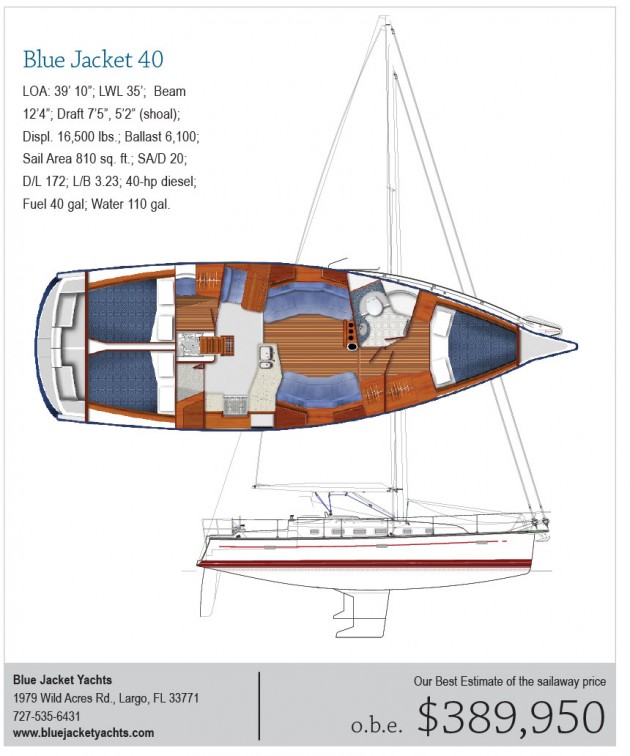Blue Jacket 40
Here's another 40-foot cruising boat. This new boat came as a bit of a surprise to me as it combines the design efforts of Tim Jackett of Tartan fame with additional design help from Bob Johnson, the designer of the entire Island Packet line. While the boat is built by Island Packet, it is being marketed separately from that line. The new design is certainly a huge departure from the Island Packet series, but at the same time it's not a Tartan either. This is a comfy cruiser designed with ease of handling and good performance as goals. You could say that about pretty much any modern production cruiser today, so let's look and see why this one is different.
The modern-looking hull has short ends with a 35-foot DWL and a D/L of 172. The displacement is only 16,500 pounds and that's pretty light for a serious cruising boat. Beam is exactly the same as my old benchmark the Valiant 40-12 feet 4 inches for an L/B of 3.23 and that's textbook normal beam. The stern is very wide.
The brochure says that the aft sections are "broad and flat"; then it goes on to say that "wetted surface is reduced." But designers know that broad flat aft sections are wetted surface producers, not reducers. You'll get a lot of stability from this broad stern and when you look at the layout you'll see what I think is the real reason for this broad stern. You can choose from two keels drawing 7 feet 5 inches and 5 feet 2 inches. With that deep, spade rudder, it's clear that this is not dad's Island Packet, but it is not a far stretch from the Tartan types.
This 40-footer has three staterooms, all with double berths. The port quarter cabin has a hanging locker and seat. The starboard quarter cabin has what I think is a desk but no hanging locker.
There is a nav station adjacent to the galley. The galley looks fine to me with plenty of counter space on each side of the range. You can access the forward head from the saloon or the V-berth stateroom.
If you don't want three cabins you can eliminate the aft starboard cabin. This way you can extend the galley and gain a huge cockpit locker.
This is a practical layout that gives very good access to the engine. The cabin sole in the aft galley area is non-skid and forward of that the sole is teak-and-holly veneer.
The brochure for the BJ 40 calls the rig a "Solent rig." That's fair. I've designed rigs like this. They have advantages in that your entire sail complement, spinnakers excluded, is up all the time and you can pick the right jib for the right conditions. Of course, tacking a genoa or a big reaching headsail through that narrow slot between the forestay and the headstay can be a challenge. But if you are not in a hurry you can roll up the big jib at least part way to make it easier to get it through the gap.
You see lots of self-tacking arrangements these days but if you have your heart set on a self-tacking working jib the Hoyt boom is the best way to go.
This boom is a great improvement over the old jib "club." It is self-vanging and this means that when you bear off and ease the sheet the lead angle for the jib sheet goes out with the boom making for a far more efficient use of the jib shape. You do have to live with a big obstacle on your foredeck all the time but at anchor I think you could tie the boom off at the lifelines and it would be pretty much out of the way. The SA/D of the BJ is 20.
This boat features a huge cockpit, partly due to all that beam aft. There are twin wheels, lots of room for a fixed dining table and a gate in the transom to access the narrow swim step. With midboom sheeting and the Hoyt boom eliminating the need for forward jib tracks, the decks are very clear. The reaching headsail will sheet to tracks outboard on top of the low bulwark.
I'd guess that Tim and Bob, both trying something new, had a lot of fun and interesting discussions while putting this design together.

Comments